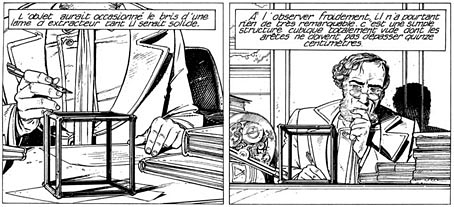
La fièvre d’Urbicande (1985) by François Schuiten and Benoît Peeters is the second volume in the Cités Obscures series. This was the one which captured my attention the most when I first saw it. The book opens with a foreword by the central character, Robick, chief architect of the city of Urbicande, in which he discusses his plans to unify the city’s separate halves by extending the design of the city’s southern half into the chaotic northern section.
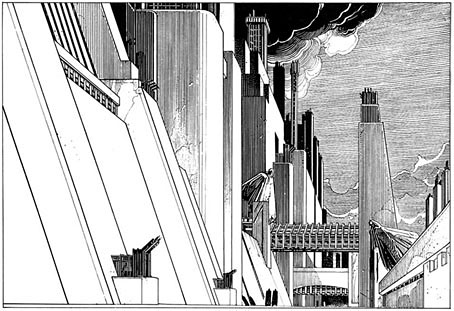
Urbicande is built on the steeply-sloped banks of a wide river. The rational, rectilinear southern bank is exposed to the sun while the northern bank is a place of shadow and mists; traffic between the two halves is strictly controlled by the administrators of the south who fear the chaos the north represents. The style of the southern region is a superb imagining of an Art Deco metropolis, the physical and psychological opposite of the north bank which is revealed as an older place of winding lanes and dishevelled buildings. In Robick’s foreword he refers to former “masters” who happen to be people from our world: architect Étienne-Louis Boullée and architectural renderer and theorist Hugh Ferriss. Mention of Ferriss was a surprise since he isn’t so well-known outside the architectural sphere. I’ve previously discussed his Metropolis of Tomorrow which is an evident influence in the style of some of Schuiten’s skyscrapers.
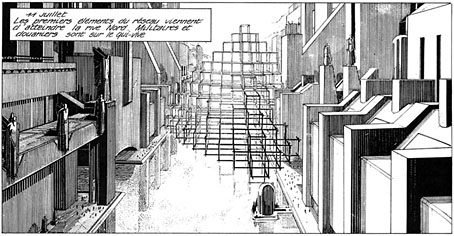
Urbicande is thrown into turmoil and near-anarchy when a small cube of some unknown material excavated in the desert is left in Robick’s office and begins to unaccountably grow, shooting out buds which form replicas of itself. The substance is invulnerable yet also passes through material objects with ease, and an evolving mesh (named The Network) of structure is soon growing out of Robick’s home and into the city.
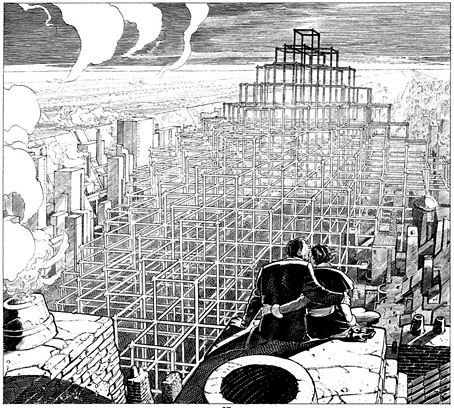
When it eventually reaches the northern bank of the river it leads to a meeting between the separated zones although not quite in the manner the architect intended. The two halves of the city are symbolic, of course, and the mind/body, rational/irrational divide is mirrored in the relationship between Robick and his brothel madame neighbour, Sophie. The use of a fantastic device to explore issues of character or morality is a common one in written fiction but less so in comic stories. Schuiten and Peeters’ fictions are closer to those of Borges (whose Tlön, Uqbar, Orbis Tertius is cited as an influence) and Calvino than the tradition of fantastic adventure stories.
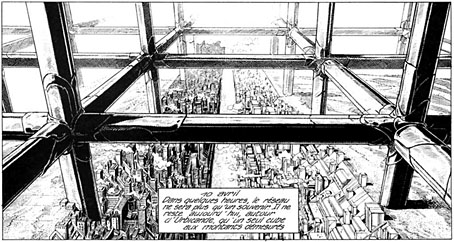
The burgeoning growth of the Network is one of the more fascinating creations from Schuiten and Peeters, and its presence recurs from time-to-time in the Obscure World. If there can be one Network, there may be others, and one of these manifests in the middle of Brasilia in an epilogue to the original story drawn some years later. An older Robick has found his way to the Brazilian capital and the appearance there of the Network seems to imply a connection with the architect.

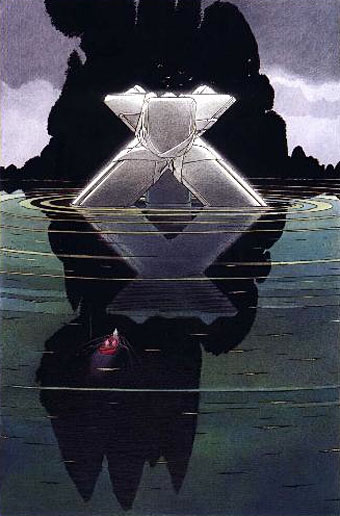
L’archiviste.
The mysterious growth is also seen in another book, L’archiviste (1987), a beautiful collection of large plates showing different views of the Obscure World. Schuiten here manages to work a variation on Arnold Böcklin’s Isle of the Dead; regular {feuilleton} readers will perhaps appreciate why I like this work as much as I do.
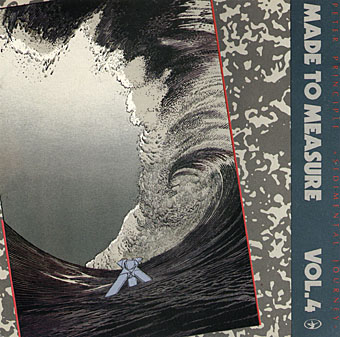
A further appearance is in another single piece which Tuxedomoon member Peter Principle used on the cover of his 1985 album Sedimental Journey. That album appeared on the Crammed Discs label which fittingly is based in Brussels. The encyclopedic Obskür site lists other notable sightings:
We know that part of the structure rose from the wave during the great equinoctial tide not far from the SODROVNI Cape, and it was also seen in ROTH and at the GREEN LAKE, as well as in the SEPTENTRIONAL and POZNAH Jungles, not to mention CHULA VISTA, the IVALO volcanic chain and the MARAHUACA Plateau.

I’ll end this by wondering whether MC Escher’s Cubic Space Division (1952) was an influence on this story. Escher had architectural interests of his own, of course, and his inventions have been borrowed by a variety of artists for many years. This is one of his more abstract works yet it sparks the imagination by seeming to be an illustration of something. Schuiten avoids Escher’s paradoxes but we’ve seen enough influences from elsewhere to make it a possibility.
Elsewhere on { feuilleton }
• The fantastic art archive
Previously on { feuilleton }
• Les Murailles de Samaris by Schuiten & Peeters
• The art of François Schuiten
• Carlo Scarpa’s Brion-Vega Cemetery
• Hugh Ferriss and The Metropolis of Tomorrow
• Taxandria, or Raoul Servais meets Paul Delvaux
• Arnold Böcklin and The Isle of the Dead

Wonderful set of posts on Schuiten! Thank you.
It would be interesting if you might cover that other great architecturally-connected, mysterious self-published comic, MAURETANIA (sp?).
This sounds fascinating! I just love the art in it and the idea behind the story so much, unfortunately my knowledge of French is sub par. :/ poot.
I’m enjoying this series of posts very much … another impressive Schuiten feat is the sheer brute work of penciling & inking all that perspective work, page after page of perfect renderings, not to mention excellent plotting, etc.
And never once does the quality slacken. A real pro!
He also did another HM piece, At The Middle Of Cymbiola, with some nice watercolor & pencil work, worth a look.
The city is reminiscent of Antonio Sant’Elia’s designs from ‘La Cità Nuova’, in particular
http://web.tiscali.it/antonio_santelia/galleria/018.htm
and
http://web.tiscali.it/antonio_santelia/galleria/037.htm
Scott: I never read much of Chris Reynolds’ work so there isn’t much I could say about it. I did read the early run of Mister X comics in the 1980s, and always liked the idea of Radiant City in that series. What I like about Schuiten & Peeters is that they create a whole world rather than a single city, and use that to tell a variety of stories, frequently using the fantasy as a technique rather than a cool idea and nothing more. As I note above, this is a common thing in sophisticated written fantasy, less so in comics, although Neil Gaiman was doing the same thing with Sandman, and there have been others.
Yohtan: Most of the major books have been translated into English although I’m not sure whether they’re still in print. But it’s true that much of the lesser material is French only. There’s a number of small books and limited edition things which elaborate on the nature of the Obscure World.
Mahendra: He’s also very adept with pencil alone. Some of the early stories written with his brother are pencil works.
Thanks, Alan. Those buildings could easily be part of the Obscure World if you put an airship in the background.
Do you have high resolution images of the spread from L’Archiviste? i cant find them anywhere!
Hi Dina. I’ve seen copies of Schuiten’s work floating around as unauthorised downloads–something which happens to many comics, including my own–but I doubt the artist would want me to point to any of those. The book itself can be bought secondhand at Abe.com if you have the money. Otherwise, I’d suggest searching some of the pages and links at Obskür, bearing in mind that most of the writing about Schuiten is in French.